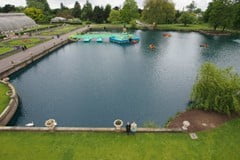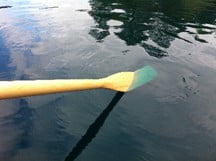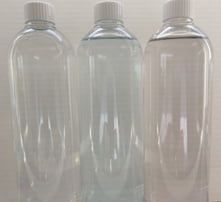Will DyoFix pond dyes work in all ponds and lakes?
Our pond dyes will create a light filter in all waters. The minimum doses do require at least 1 metre of overall depth, anything less requires more to compensate, for example, a pond at half a metre will need a double dose.
Please note that not all weeds and algae are susceptible to treated water at minimum concentrations.
How long the pond dye last?
There is no definitive answer to this question as strong sunlight and rainfall both have an effect on the dye. The Sun will fade the dye and rainfall will dilute it. We suggest that a monthly top up of 10 to 15% of the original dose should be made in order to keep the dye concentration at its best.
I have fish in my pond, will they be safe?
The dosage recommended is very low and has no effect on fish. The European regulations have a fish test that uses the dyes in concentrations 1000 times greater than our suggested dose without any harmful effects.
My pet drinks from our pond, will it be ok?
Dogs, cats, rabbits… We have been asked this question many times and there appears to be many exotic ‘pets’ as well as the more popular ones. Water treated with DyoFix pond dyewill not be any different to the way it was before being added, so, if the pets were OK before, they will remain that way. Please be aware of Blue Green Algae: https://www.bluecross.org.uk/pet-advice/blue-green-algae-and-its-dangers-dogs
Our pond is visited by frogs/newts/Insects/invertebrates/dogs/cats/rabbits/insects – will the treated water be safe for them to drink?
The actual dye content in the water is very low and will not be harmful.
An interesting observation:
Please note that a well known brand of energy drink has 65 times more dye per litre than a litre of pond water dosed at the minimum rate!
Do Dyofix pond dyes help to reduce weed growth as well as algae?
Yes. Rooted weeds at the bottom of the pond require sun light to grow in exactly the same way as algae. Weeds that have leaves at, or above the surface of the water will be able to benefit from the sun light, so it is recommended that Dyofix pond dyes should be applied in early Spring before the weeds start to grow. Prevention is always better than a cure!
The weeds in our lake are growing, is it too late to use DyoFix pond dye?
Some weeds require more light than others to photosynthesise, those requiring a lot of light may not be able to support their own growth even when they have hit the surface. As stated above, try to apply the first dose in spring before growth is established.
What happens if we put too much pond dye in our water?
The water will be a deeper shade, and possibly opaque. Over time, rainfall will dilute the colour to the point where it will all be gone. It can also be diluted by adding more water. If emptying the pond is required, the water should be flushed into soil beds – please avoid letting over dyed water get into surface drains or streams. Any water getting into a stream or drain will not be harmful, but anyone seeing coloured water flowing by may report this “pollution” to the authorities for investigation.
Do your products need to be licensed by any authorities?
NO.
Before they were banned, chemical remedies, collectively known as Biocides (algaecides, herbicides etc) did require approval in the UK by the Health & Safety Executive under “The Biocidal Products Directive (98/8/EC)” which is implemented in Great Britain by the “Biocidal Products Regulations (BPR)”, “The Control of Pesticides Regulations (COPR)” or “The Plant Protection Products (PPP) legislation”. From 18th March 2010 these products had to be withdrawn from the market throughout Europe.
Some useful links:
Does the pond dye stain?
In concentrated form, dyes WILL stain hands and clothing, so it is always recommended that gloves should be worn when handling the products. At recommended dilution rates no staining will occur.
DyoFix Pond Black uses a higher concentration of dye and may result in slight discolouration of surrounding stones and water features.
Spillages of the dye on surrounding areas should be washed with copious amounts of water first and strong sunlight should fade any residue.
Is it safe to swim in water treated with Dyofix pond dyes?
Yes. All Dyofix Pond products are made using European Food Approved Colours, but give the concentrated dye time to mix into the water before diving in!
Can we use more than the recommended dose?
 Yes. Dyofix can be overdosed by many hundreds of times. It is sometimes necessary to add more than the minimum dosage, for example, if the weeds have grown and are getting near to the surface, this is normally 2, 3 or 4 times the minimum, but it depends on just how close to the surface the weeds are. There are a few lake owners that want to enhance the look of their lakes and, as with Kew Gardens in 2013, they used 10 times the minimum dose.
Yes. Dyofix can be overdosed by many hundreds of times. It is sometimes necessary to add more than the minimum dosage, for example, if the weeds have grown and are getting near to the surface, this is normally 2, 3 or 4 times the minimum, but it depends on just how close to the surface the weeds are. There are a few lake owners that want to enhance the look of their lakes and, as with Kew Gardens in 2013, they used 10 times the minimum dose.
I have seen photographs where Dyofix Pond Blue has been used and this made the water look very blue, why is that?

There can be many reasons, photographs taken as the pond is being dosed, owners deliberately over dosing for effect, even the reflection of a blue sky can make the water look bluer than it actually is. It is almost impossible to capture just how pale the water is once coloured.
 How deep in shade will the water be once the pond dye has been applied?
How deep in shade will the water be once the pond dye has been applied?
The illustration here shows that the minimum dose is almost imperceptible. Please note that the colours shown are indicative and are not intended to be taken as accurate.
How long does it take for Dyofix pond dye to mix into a pond?
This depends on a number of factors. The size of the pond – with a very big pond, it may be difficult to reach the middle (without using a boat). The “stillness” of the water – the more movement of the water, the quicker the pond dye will mix. If re-circulating pumps are used the mixing will take less time. The simple movement of fish helps to distribute the Dyofix.
Will the Dyofix damage water pumps?
No. The dye is completely soluble and will pass through pumps and filters very easily.
Can Dyofix be used with other pond dyes?
Dyofix Pond Blue can be used with other chemicals provided that they are not Chlorine based. Chlorine will attack the dye by bleaching it and rendering it useless.
What do I do with unused Dyofix pond dye?
Keep it in a cool, dry place with the lid firmly in place and use it for “topping up” or the following years(s). Stored in this way, Dyofix has a long shelf life.
Is there any special way to dose a lake?
While there is no official or definitive method for treating a lake, we recommend applying the product evenly around the edge to allow for uniform distribution. Please see the below Video.
Not so frequently asked questions about pond dyes
Some questions are not frequently asked, but we do try to answer them, here are a few examples:
How much DyoFix pond dye would I need per gallon in a medium-sized garden pond?
We always show the number of litres that a given quantity of DyoFix pond dye will treat. It is easier to calculate a volume of water using metric sizes than Imperial – The answer, using DyoFix SGP 15 is 0.1ml per gallon!
Will the roots take up the dye so that flowers and leaves will change colour?
This question could not be answered with a simple yes or no, all we could say was that we have never heard of this happening by any of our customers – we believe that it is not likely because the concentration of the dye is very low once mixed into the water.
Once the dye is used would it be much more difficult to locate a small child should they fall into the water?
Our most infrequently asked question ever!
The potential customer was considering using DyoFix Pond Blue or DyoFix Lake Shadow, so the water remains transparent and the falling child would still be visible. If DyoFix Pond Black was used, in a deep pond, then there would be a concern! We have customers with ponds in gardens that are open to the general public and for Health and Safety reasons they have grids near to the surface of their ponds (to prevent accidentally falling in) – To hide the often unsightly grids, DyoFix Pond Black is used.
Can I talk to anyone who has used Dyofix Products?
Please contact us Email Dyofix and we will provide you with names and telephone numbers to enable you to gather opinions.
We always try our best to answer all questions about our products, no matter how obscure, so please feel free to ask.
Why has my credit card got an extra £1 charge on my statement?
When collecting payment data our Merchant processor Stripe may send a request to your issuing bank for either £0 or £1 authorisation to verify that your card has been issued and your bank will allow your card to be authorised. The authorisation request is reversed immediately. However some customers may still see an authorisation amount on their statement; depending on the bank it will be removed from anywhere from a few minutes to a few weeks.
Stripe will first attempt a £0 authorisation in all cases except AMEX (which doesn’t support £0 authorisations – we try a £1 authorisation right away with AMEX.


 Yes. Dyofix can be overdosed by many hundreds of times. It is sometimes necessary to add more than the minimum dosage, for example, if the weeds have grown and are getting near to the surface, this is normally 2, 3 or 4 times the minimum, but it depends on just how close to the surface the weeds are. There are a few lake owners that want to enhance the look of their lakes and, as with Kew Gardens in 2013, they used 10 times the minimum dose.
Yes. Dyofix can be overdosed by many hundreds of times. It is sometimes necessary to add more than the minimum dosage, for example, if the weeds have grown and are getting near to the surface, this is normally 2, 3 or 4 times the minimum, but it depends on just how close to the surface the weeds are. There are a few lake owners that want to enhance the look of their lakes and, as with Kew Gardens in 2013, they used 10 times the minimum dose.
 How deep in shade will the water be once the pond dye has been applied?
How deep in shade will the water be once the pond dye has been applied?